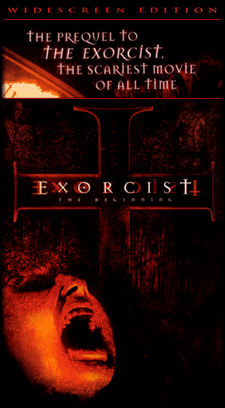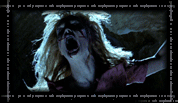


Having abandoned
his faith in God, Father Merrin joins a British archaeological excavation
in Kenya, where an inexplicably pristine Christian Byzantine church has
been unearthed - looking as if it had been buried on the day it was completed.
But beneath the church, something much older sleeps, waiting to be awoken.

"You want the whore, don't you? You wanna stick your big rotten cock up her juicy ass?"
- Sarah Scorupco |

After a prologue
showing a priest walking through the results of an astonishing massacre,
we meet a young Father Merrin (Stellan Skarsgard) not long after he's abandoned
his faith and is considering himself an archaeologist rather than a priest.
Merrin is asked in his new capacity to travel to British East Africa, where
a Christian church has been discovered 1500 years older than any church
in the area should be. He's specifically asked to find a particular relic/statue--of
Pazuzu, the infamous demon from the Exorcist films. The bulk of Exorcist:
The Beginning has Merrick in what has come to be known as Kenya, exploring
the bizarre occurrences surrounding the town where the church is located,
the other European residents, the natives, and of course the church itself.
Since this is
well set up as a prequel, I recommend watching Exorcist: The Beginning as the first film in the series. There is no need to watch any of the other Exorcist films before you see this one.
This film is
getting knocked a lot, but I can't help thinking that much of it might
stem from the fact that Morgan Creek initially had Paul Schrader shoot
the film, then canned the result when he turned in his cut. It was said
that they believed Schrader's version wasn't "visceral" enough. So they
hired Renny Harlin to direct and had a completely new script written, although
one still based on novelist Caleb Carr's initial treatment, which he wrote
after finding an older script that had been languishing in Morgan Creek's
vaults, or "tomb", as he calls it (Carr has been employed as a "script
polisher" for Morgan Creek). In any event, I agree that Morgan Creek's
actions were loathsome, especially their eventual decision to not include
Schrader's version on the same DVD as Harlin's (initially they had promised
this, but it seems that they have some other scheme in mind for trying
to recoup some of the money sunk into the fiasco). But I don't agree that
Morgan Creek's actions make Harlin's film bad by association. It isn't.
Harlin's effort
certainly is visceral--wonderfully so. He lets us know this from the first
frames by showing us the haggard priest's face overbaked by desert sun
and wind and then pulling back to a wider shot showing the massacred bodies.
The film has an incredible visual style. The gorier aspects are extremely
well done--always servicing the story and having maximum impact. The special
effects are often subtle and for my money, the sparse use of cgi (most
noticeably with the hyenas) is handled brilliantly.
The current
trend towards monochromatic cinematography is strongly present, but rather
than overused blues, Harlin has cinematographer Vittorio Storaro embed
us in browns/sepia tones and grays with many scenes having very deep shadows.
Harlin has said that he was aiming for the look at the end of Apocalypse
Now, when Captain Willard (Martin Sheen) finally encounters Colonel
Kurtz (Marlon Brando) in Kurtz' compound. It was probably no accident then
that Storaro was chosen, as he was also the cinematographer on that Francis
Ford Coppola masterpiece. Amusingly, Harlin and Storaro reference Apocalypse
Now many times during Exorcist: The Beginning. For example,
we get shots looking at Father Merrin from above a ceiling fan. One sequence
is even constructed similarly to the opening scene of Apocalypse Now and ends with Father Merrin breaking a mirror.
But Harlin references
all of the Exorcist films to date as well. This helps integrate Exorcist:
The Beginning into the mythos of the series, deepening the stylistic
and subtextual ties. The bulk of The Beginning can be scene as an
extension of the middle section of John Boorman's severely under-appreciated Exorcist
II: The Heretic. Although the details may have been changed, The
Beginning's plot is very similar to Merrin's trek to Africa to explore
a mysterious church in Boorman's film. The only thing lamentably missing
is a reference to locusts, or the locust man. Harlin also gives us an excellent
asylum scene and more subtle nurse references that are reminiscent of The
Exorcist III. And of course there are numerous references to the "big
daddy", The Exorcist. These range from admirable small details,
such as the supernaturally halting pendulum, to major plot elements, such
as Pazuzu and a possessed woman looking and sounding very similar to a
pea soup-vomiting Regan.
Although an
artistic triumph, Harlin may have chosen a hurdled route in presenting
a film that is often "difficult". He doesn't pander to shortened attention
spans or a need for a clearly linear, simple plot line. The pacing of many
scenes is not what most viewers would expect, but it's always right for
the scene, at least in retrospect. The cast turns in complex performances,
and Harlin requires that you pay rapt attention to visual cues--silence
is often stretched while narrative is conveyed in a manner closer to a
silent film. Part of Harlin's more studied approach may have been due to
an attempt to bridge the style and language of film-making circa 1973 with
modern sensibilities. Whatever the motivation, it works, but Exorcist:
The Beginning isn't exactly a "popcorn film".
The most obvious
themes and subtexts are those related to faith and the nature of evil,
but Exorcist: The Beginning also has interesting things to say about
European colonization and domination of non-European cultures and religious
and other cultural appropriation/absorption of preexisting Others. The
latter subtext is interestingly present in a very literal way in the church
that is the focus of the film.
But the primary
attraction is the emotionally dark face of Exorcist: The Beginning,
and its comfortable place in a very unusual series of films. Don't let
Hollywood's behind-the-scenes blunders dissuade you, this is a film that
deserves to be watched and appreciated.
 | |  | |  | | 

- John Frankenheimer voluntarily stepped down from directing the
movie one month before his death.
- Ryan Phillippe and Kerr Smith were both considered for the role
of Father William Francis.
- Liam Neeson was initially cast as Father Merrin.
- Morgan Creek Productions fired Paul Schrader after he had submitted
a completed movie, saying that he had given them "footage without any of
the bloody violence the backers had wanted". He had already made it clear
in interviews that he was making more of a psychological drama than an
all-out gore-fest. He was fired and Renny Harlin was hired to re-shoot
the movie. Almost 90% of the movie was re-shot and at least two characters
have been dropped from Paul Schrader's version of the movie. Following
the lackluster reception to Harlin's version, though, Schrader's version
was finally released as Dominion: Prequel to the Exorcist.
- Michael
Kamen had originally been selected to compose the score. Schrader replaced
him with Christopher Young shortly before his notorious "exec screening"
that had him replaced as director.
- After director John Frankenheimer abandoned the project, it was
rumored that Morgan Creek producers would hire David Rocksavage to go on
with the movie. These rumors were proved wrong when Paul Schrader was hired.
- Several changes followed the firing of Paul Schrader, both in
crew and cast. Screenwriter Alexi Hawley was called to retool the previous
script, and he cut off some characters of Paul Schrader's version, besides
adding some new ones, like the one played by actress Izabella Scorupco.
Actor Gabriel Mann, who played Father Francis in the original version,
was not able to re-shoot his scenes due to schedule problems, so new director
Renny Harlin replaced him with James D'Arcy.
- Stellan Skarsgård is playing a younger version of Max von
Sydow's character from The Exorcist. Skarsgård is nearly a
decade older than von Sydow was during the filming of the original movie.
- The producers considered bringing back William Friedkin back to
direct.
- Linda Blair was "shocked" when she discovered that Warner Bros.
had used her image/voice in the promotional campaign(s), unauthorized.
- The film was originally rated NC-17 "due to the film being too
graphic and violent". The offending scenes were edited and the result was
the R-rating for "strong violence and gore, disturbing images and rituals,
and for language including some sexual dialogue".
- Just at the start of the re shoot, Renny Harlin was involved in
an accident and broke his leg. He had that leg supported by metal support
and a cast.
- Roughly 10 percent of Paul Schrader's scenes were made into the final film:
two minutes of the Holland village massacre. Schrader's version of the
sequence is at about 20 minutes long.
     



|



















